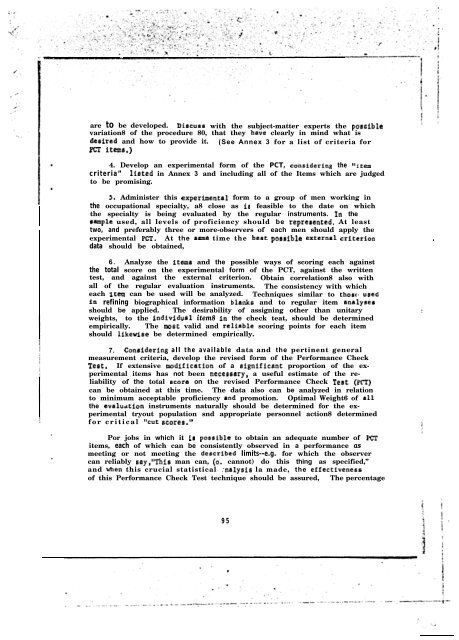Technical Report - International Military Testing Association
Technical Report - International Military Testing Association
Technical Report - International Military Testing Association
Create successful ePaper yourself
Turn your PDF publications into a flip-book with our unique Google optimized e-Paper software.
.<br />
.<br />
are to be developed. Discus6 with the subject-matter experts the posl;ible<br />
variation8 of the procedure 80, that they have clearly in mind what is<br />
deefred and how to provide it. (See Annex 3 for a list of criteria for<br />
m iteIII8.)<br />
4. Develop an experimental form of the PCT, coixsidering the "item<br />
criteria” lieted in Annex 3 and including all of the Items which are judged<br />
to be promising.<br />
5. Administer this experfmental form to a group of men working in<br />
the occupational specialty, a8 close as fe feasible to the date on which<br />
the specialty is being evaluated by the regular instruments. In the<br />
rample used, all levels of proficiency should be reprerented. At least<br />
two, and preferably three or more-observers of each men should apply the<br />
experimental PCT. At the 8ame time the be8t posrible externel criterion1<br />
data should be obtained,<br />
6. Analyze the item8 and the possible ways of scoring each against<br />
the total score on the experimental form of the PCT, against the written<br />
test, and against the external criterion. Obtain correlation8 also with<br />
all of the regular evaluation instruments. The consistency with which<br />
each ttw can be used will be analyzed. Techniques similar to thorc, used1<br />
fa refining biographical information blank8 and to regular item analyser<br />
should be applied. The desirability of assigning other than unitary<br />
weights, to the individu81 item8 In the check teat, should be determined<br />
empirically. The most valid and relipble scoring points for each item<br />
should lfkewise be determined empirically.<br />
7. Coneiderfng all the available data and the pertinent general<br />
measurement criteria, develop the revised form of the Performance Check<br />
Teat. If extensive modification of a eignlficant proportion of the experimental<br />
items has not been neceeeary, a useful estimate of the reliability<br />
of the total score on the revised Performance Check Test @CT)<br />
can be obtained at this time. The data also can be analyzed in relation<br />
to minimum acceptable proficiency 8nd promotion. Optimal Weight6 of all<br />
the evalucltion instruments naturally should be determined for the experimental<br />
tryout population snd appropriate personnel action8 determined<br />
for critical “cut score8.”<br />
Por jobs in which it ir pO8Sible to obtain an adequate number of PCT<br />
items, each of which can be consistently observed in a performance as<br />
meeting or not meeting the deecribed limits--e.g. for which the observer<br />
can reliably say,“This man can, (0. cannot) do this thing as specified,”<br />
and when this crucial statistical .-nalysis la made, the effectivenees<br />
of this Performance Check Test technique should be assured, The percentage<br />
95<br />
.









